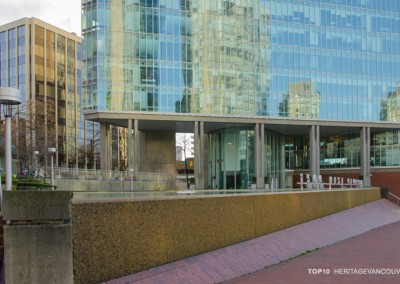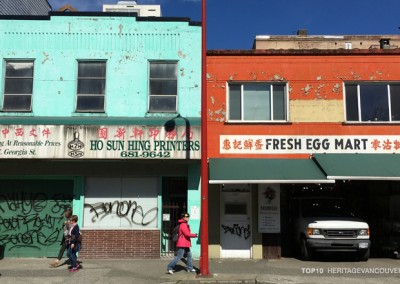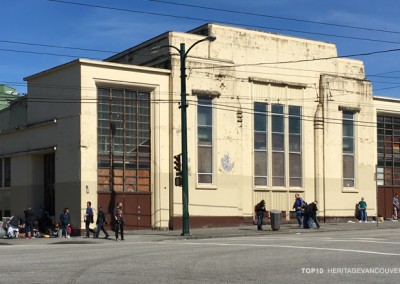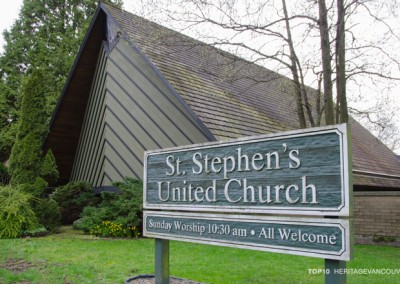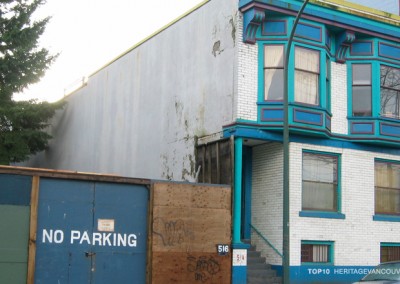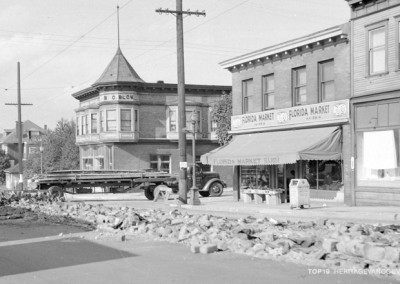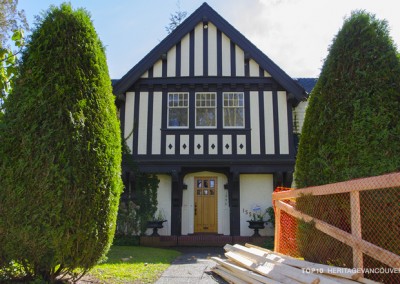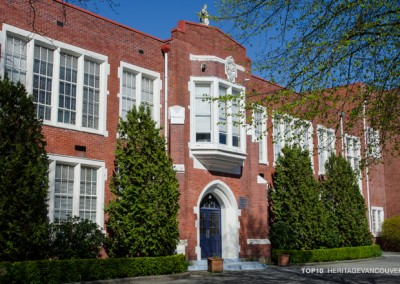The demolition of Sir Sanford Fleming School, and its replacement by a new school, has just been announced. Which historic Vancouver school is next on the hit list?
Bayview Community School is a historically significant landmark in the Kitsilano neighbourhood. Built in 1913-14 in the Classical Revival style, it is one of Vancouver’s most impressive Edwardian-era elementary schools. The Vancouver School Board’s 2016 Interim Long Range Facilities Plan proposes that Bayview will be one of the 14 Priority Projects to proceed without delay under the seismic mitigation program.
Seven of the 14 schools, including Bayview, are listed on the Vancouver Heritage Register, but this does not protect them from demolition. Until the School Board undertakes heritage value assessments of the schools as part of their seismic mitigation process, they can be considered threatened. Many heritage schools have already lost.
With more creative solutions, essential seismic upgrades can be achieved without the destruction of our valuable heritage schools.
Threat
What is the threat to Bayview Community School?
The immediate threat to our heritage schools is the provincial seismic mitigation program, and the way it is being implemented by the Vancouver School Board.
The province has just announced its approval of the demolition of Sir Sanford Fleming School. Originally designed by J.H. Bowman in 1912 as Gordon School, it was one of the large new brick schools built for the South Vancouver School Board to accommodate the area’s growing population. It was enlarged in 1929 to the designs of prominent local architects Townley & Matheson.
Since the late 1980s, the Ministry of Education has recognized the need to address the seismic upgrading of public schools to provide a safe school environment. Currently, over 150 seismic upgrade projects across British Columbia have been completed or are under construction. However, only 20 of Vancouver’s 110 schools have been seismically renewed, and 5 are under construction; 64 high-risk schools still need to be upgraded. Of these, 24 have proceeded to the project definition stage, leaving 40 unapproved by the Ministry. According to the Ministry of Education, all of the high-risk schools that have not yet received attention are located in Vancouver.
Many other communities, including Victoria – with its many heritage schools – have managed to seismically upgrade their schools without resorting to widespread demolition. The lack of adequate provincial funding is the main reason the Vancouver School Board gives for not being able to retain heritage schools during the seismic mitigation process. The cost of upgrading the schools is inflated, because for years the Vancouver School Board has deferred maintenance on these schools. The School Board also claims that old schools are inadequate and outdated for today’s educational needs. The result is that in most cases, existing heritage facilities are abandoned for replacement schools.
The School Board is now updating its Long Range Facilities Plan. Part of this process is to identify how to increase the capacity utilization, from the current level of 85% to the Ministry of Education’s target rate of 95%. The Board estimates that this could require the closing of 12 or 13 schools. This puts further pressure on heritage schools that are now at low capacity, such as Carleton School, 3250 Kingsway, with a capacity utilization of only 50%. Please refer to the 2011 Top10 Endangered Sites list for a description of the four heritage buildings, dating from 1896 to 1912, which comprise the large Carleton School complex.
http://www.heritagevancouver.org/topten/2011/topten2011_01.html
Many cities have managed to modernize and seismically upgrade their schools without this level of destruction of community heritage resources. Heritage professionals are often consulted after internal decisions are made to replace the school facility. Rather than defaulting to demolition, Vancouver School Board should explore all options to upgrade their heritage buildings, or if that is not feasible, to retain the most significant portions of the existing buildings.
Unless there is a major change in the VSB’s approach to the seismic mitigation program, any high-risk school not yet upgraded is now threatened with demolition.
Significance
Why is Bayview Community School significant?
Bayview is one of the most distinctive, sophisticated and intact heritage schools in Vancouver. Designed in 1913, the school opened in 1914, when the Kitsilano neighbourhood was rapidly expanding, and underwent a major expansion in 1929 to accommodate new students from Point Grey municipality, after its annexation with Vancouver.
The architects for the first sections of the building specialized in school design. Norman A. Leech, School Board architect, designed the 1913-14 north wing in a Classical Revival style, faced in brick with a slate roof. In 1929, Harry W. Postle designed the south wing to match, and completed the barbell plan. Further additions were made to the site in 1962.
Bayview is a well-designed school. There are generous banks of multi-paned windows throughout for access to natural light and ventilation. The open area teaching space, created in the 1970s, and the dedicated art room, both illustrate how the school has been adapted over time for new teaching concepts.
Important architectural features are the symmetrical barbell form, pedimented gable parapets, classical metal cornices and the gable pediment over the front entry, with a lintel incised ‘Bayview School.’ The reddish-brown brick walls have running courses of cast-in-place concrete that produce a banded masonry pattern. The large multi-paned windows have 6-over-6 wooden sashes, providing large, naturally lighted interior spaces. Original millwork, window casings, high baseboards, panelled wood doors, and hardware have also been preserved.
Bayview Community School is also important for its strong tradition of parent participation and community involvement. Vancouver’s first Parent-Teacher Association (PTA) was organized here and helped shape the physical setting. In 1970, parents, teachers, students and landscape architect Art Cowie designed and installed an outdoor creative play area. A few years later, the PTA was awarded the first designation of a community school in Vancouver. Today, Bayview continues to serve the Kitsilano neighbourhood with pre-school and after-school programs, and sports activities.
Bayview Community School is listed on the Vancouver Heritage Register, and its heritage significance has been documented through a Statement of Significance on the Canadian Register of Historic Places:
http://historicplaces.ca/en/rep-reg/place-lieu.aspx?id=11313&pid=0
Position
Heritage Vancouver’s position
Heritage Vancouver supports the retention and upgrade of Bayview Community School.
We encourage Vancouver School Board to hire a heritage professional to prepare a Conservation Plan before final options are considered.
Heritage Vancouver believes heritage professionals, operating at arms length, can ensure that community assets are retained, where possible, and that the renewal of heritage schools can be successfully achieved through adherence to conservation principles.
We further encourage the VSB to provide commemorative information to communicate to the public, students and staff the historical value of Vancouver’s heritage schools.
Actions
What you can do
We strongly encourage the citizens of Vancouver to:
- Ask the Vancouver School Board for information on the future of your neighbourhood school or a school that you attended. Find out more about the history of schools you do not want to see demolished.
- Become involved with a group in your community, a PAC, Community Association or other group that is engaged in the seismic mitigation process and let the Vancouver School Board know which schools should not be demolished.
- Write to a Vancouver School Board trustee or your local MLA and let them know that you want to see your community school retained as part of the seismic mitigation process. Attend a Vancouver School Board Meeting and ask questions about the future of your community school.
- Contact municipal political parties, or talk to a School Trustee and ask them to outline their position on the retention of heritage schools.


